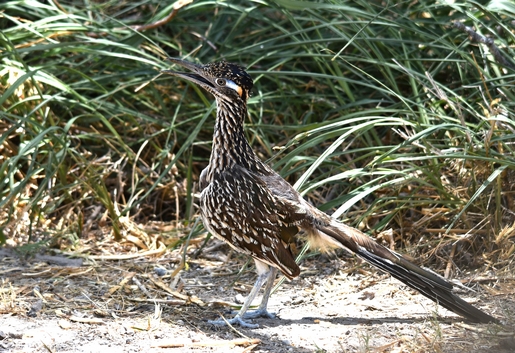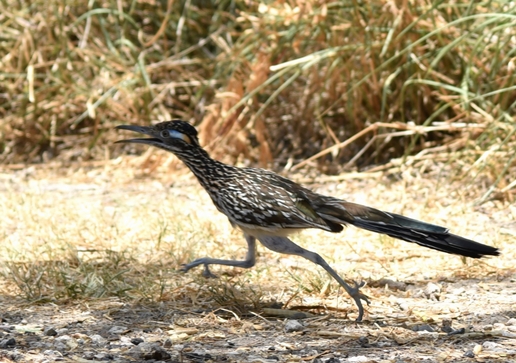It was a late July Dog Day Afternoon – perfect for a tram ride at Bentsen-Rio Grande Valley State Park in Mission. South Texas Border Chapter Texas Master Naturalist, Jani McGee, drives the tram Thursday afternoons from 1 to 4 p.m., making rounds at the top of each hour. Bring a camera, grab a cold can of lemon iced tea at the visitor’s center and hop on the tram. You can ride as long as you like. Jani accommodates stops for photo ops, so long as she’s on time getting back to base.

Toward the middle of our first round, we were about to take off from a stop when something in the distance was approaching at speed down the middle of the road. I aimed the camera through the tram windshield, ready to get a shot of whatever it was. As it got closer, Jani said, “roadrunner.” I began focusing and shooting. The bird was charging hell-for-leather, chattering away, like it was excited to see us.
As it neared the tram, it scooted off the road and slowed pace, obviously familiar with the vehicle. I slid out of my seat and quietly walked to the rear and captured more photos. And just like that, I had my bucket-list-photo of a roadrunner! And then it was off again!
Greater Roadrunner (Geococcyx californianus) is a bird that prefers sprinting to flying; it can run to speeds around 20 miles per hour – the fastest known ground speed for a bird of flight, according to blog.eyewire.org. Before you ask, coyotes can reach speeds more than double that of a roadrunner.

Roadrunners are a large slender bird about 20 to 24 inches in length with a wingspan of 32 inches – when they choose to reveal it, which displays a white crescent in their primary feathers. The overall feathers are a streaking of tan, brown/black and cinnamon colors. The birds have a long bill tipped with a hook, a shaggy crest, tan legs and blue feet. There is a patch of bare skin around and behind the eye that is blue proximally to red to orange distally. Plumage is similar in both sexes.Subtle, but striking plumage of Roadrunners

Roadrunners run on the ground in pursuit of a meal, seldom flying for prey. They are agile on the ground, racing along roads and paths, using their long tail as a rudder. They eat insects, snakes, lizards, rodents, small birds, and some fruits and seeds. They can jump, which allows them to take insects from the air and snag hummingbirds and bats in flight. They don’t fly so well; flying is limited to gliding from nest to perch to ground or perch to perch or to seek a hiding place. Their predators are raccoons, hawks and coyotes.
A shy bird and often solitary, roadrunner pairs are known to hold their territory all year, which may encompass an area of a half-mile in diameter. They are nonmigratory. Although rare to see a gathering of these birds, collective nouns for such a sight would be a marathon or race of roadrunners. They are monogamous birds and may mate for life, renewing their bonds each spring with a courtship dance.
While adult roadrunners are terrestrial, their nest-building will be in shrubs, trees or cactus from two to 12 feet above ground. The male brings twigs to the female, who builds a compact nest, lining it with grass, mesquite pods, leaves, feathers, snakeskin and flakes of horse and cattle droppings. A finished nest may reach more than 17 inches in diameter and eight inches high. The female will lay two to eight eggs and have one to two broods a year, depending on food resources. Both parents care for the young and may continue to work on the nest during incubation and possibly continue to build up the sides of the nest as the chicks grow, according to All About Birds.
Greater Roadrunners are year-round residents of Texas, Oklahoma, New Mexico, Arizona and southern California and found throughout eastern, central and northern Mexico. The Lesser Roadrunner (Geococcyx velox) range is along the west coast of Central America from northern Mexico to Nicaragua.
Interestingly, the Groove-billed Ani and Yellow-billed Cuckoo are Valley summer resident birds in the same family as the greater roadrunner, the Cuculidae family.
The Greater Roadrunner is the newest Texas conservation license plate in a Texas Parks and Wildlife Department program that helps raise money to support and expand wildlife programs, habitat conservations work and nature tourism in Texas. It can be ordered online: